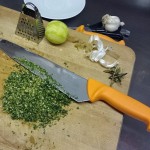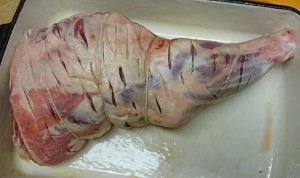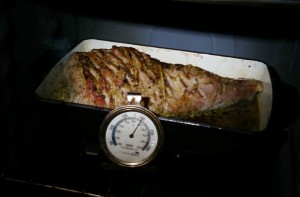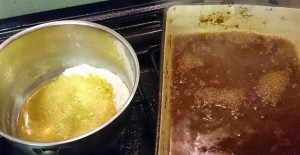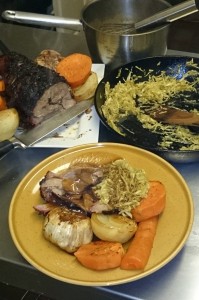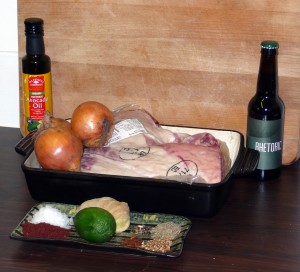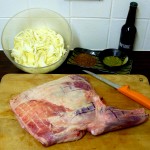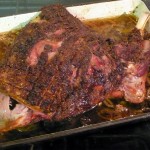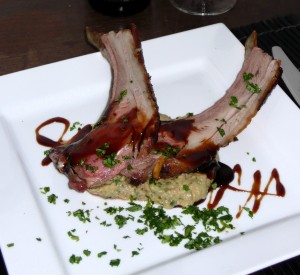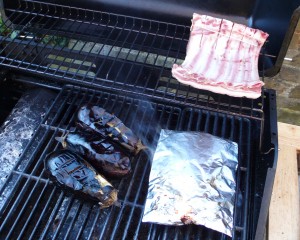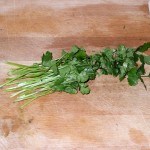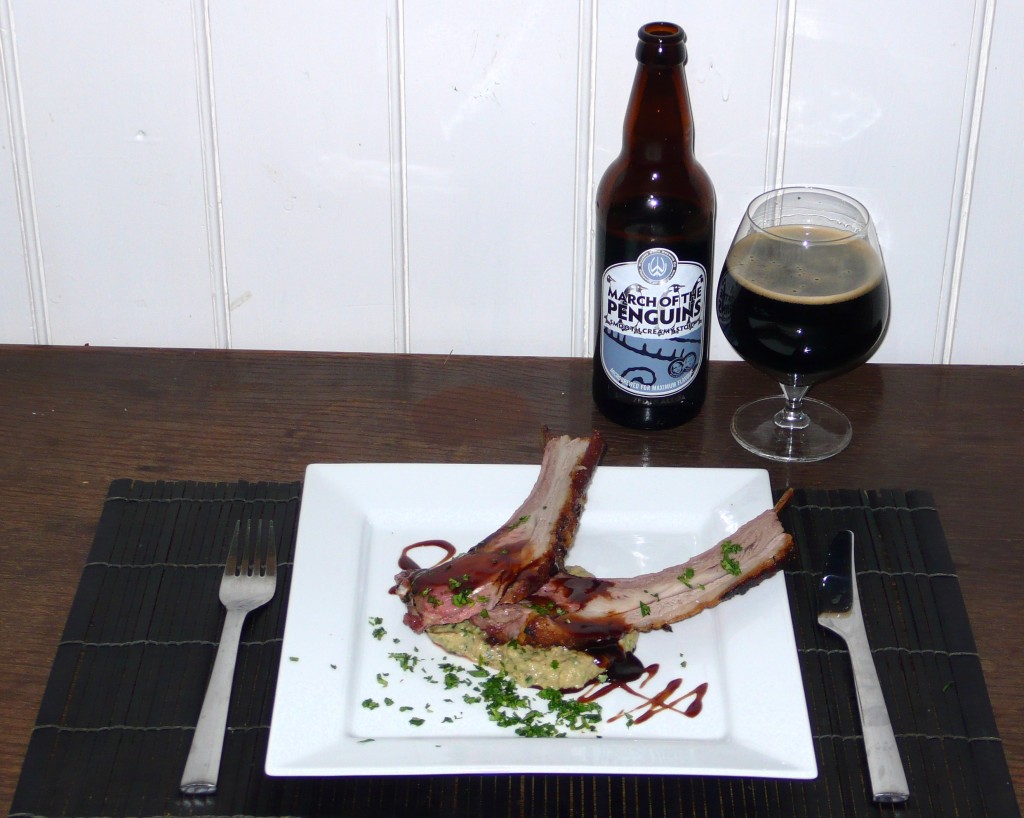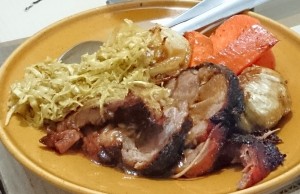 My previous beery recipe for a beery Char Sui(ish) Pork could be said to be somewhat… complicated. It’s a labour of love, a multi-stage dish designed for show & a special occasion. Sometimes you just want to slap together a hearty meal however – and roasts and stews are, in my mind, the ultimate bang-for-buck slap-up presentation dish. So on this wet winter evening, with a sad pint of the dregs of our Christmas mini-cask of delicious toasty-maltbomb BlackBar Porteur in front of me I was thinking roast lamb. We don’t have lamb very often despite it being my favourite of the traditional roasting meats – lamb is just so expensive. But it is that special time of year leading up to the end… or the start… depending on how you look at things. So we went and fetched ourselves a partially boned out 1.5kg rolled shoulder of British lamb.
My previous beery recipe for a beery Char Sui(ish) Pork could be said to be somewhat… complicated. It’s a labour of love, a multi-stage dish designed for show & a special occasion. Sometimes you just want to slap together a hearty meal however – and roasts and stews are, in my mind, the ultimate bang-for-buck slap-up presentation dish. So on this wet winter evening, with a sad pint of the dregs of our Christmas mini-cask of delicious toasty-maltbomb BlackBar Porteur in front of me I was thinking roast lamb. We don’t have lamb very often despite it being my favourite of the traditional roasting meats – lamb is just so expensive. But it is that special time of year leading up to the end… or the start… depending on how you look at things. So we went and fetched ourselves a partially boned out 1.5kg rolled shoulder of British lamb.
BlackBar Porteur – 4% – This porter was brewed for the Maypole pub. That had requested a ’porter’ for there beer festival which runs along side the Cambridge Beer Festival every year. So after a lot of reading and some wondering in the malt store i came up with this malty session porter. (From BlackBar website.)
The roast itself is typically simple. Preheat your oven to 220°C. Get together some herbs, the garden is pretty scant at this time of the year but I managed to gather some rosemary, a bit of dodgy looking sage, some fronts of fennel, and a little curly parsley. These herbs – rinsed and squeezed dry in a teatowel plus a couple of beefy cloves of garlic, the zest of a lime, and the chopped skin of a preserved lemon – are finely chopped before being pounded in a mortar & pestle with ½ teaspoon each of salt & pepper plus the juice of the lime and 4 tablespoons of rapeseed oil (or whatever you have to hand).
Death by 1000 cuts… that’s the treatment I give the lamb joint. Lots of little incisions just barely through the fat layer – this helps get flavour into the meat. Rub the oily mixture into the lamb – give it a good sensual massage, reserving a tablespoon of mixture to place under the joint. Pour the pint of beer around lamb – not over it.
Place in oven and sizzle until browning – this took 30 minutes in my pathetic oven but should take no more than 20 in a good one.
When the sizzle is done drop the oven temperature to 160°C, pull the lamb out of the oven and drizzle 2 tablespoons of honey over the joint. (It may help to warm the honey in hot water or a microwave to make it runny). The honey should evenly glaze the lamb and catch in the little divots made by the cuts. Pop the roast back into the oven.
Slow-roast at 160°C for 2 hours. At this point I popped myself out to the local pub and had a couple of pints. That’s what roasts & stews are all about :) relaxing whilst dinner cooks itself.
After an the 2 hours are up add your vegetables to the roasting dish, in my case: peeled sliced sweet potato, 2 whole heads of garlic, a couple of big carrots halved each way, a couple of halved onions. Baste the meat with fat from the roasting tin and then pop back into the 160°C oven for another 45 minutes – or until vegetables are tender.
Done. Before the 2 hour roast we had finely sliced some cabbage and sprinkled with salt. This was set aside while the roast was happening. When the roast was removed from the oven the cabbage was rinsed with water, spun in a salad spinner, and then sizzled & softened in lamb fat from the roasting dish plus a couple of tablespoons of tarragon vinegar.
The roast joint and vegetables were removed to a warmed plate. The pan juices had excess fat siphoned off with a turkey baster and were kept simmering on the stove. In a small saucepan 2 tablespoons of rapeseed oil and 2 tablespoons of plain flour were cooked together until sizzling for a minute before the pan juices were gradually poured in through a sieve. A little at a time whisking all the way. Initially it’ll seem very doughy – but once all the juices are combined in you should have a good thick gravy.
And we’re done… have some warmed plates ready and serve. Enjoy with a beer. Some take-home Adnam’s Tally Ho in this case – and the BlackBar Porteur made for the backbone of a damn fine gravy.
Ingredients Checklist
- 1 pint of dark not-too-bitter ale, a porter is usually a good choice
- A 1.5kg to 2kg roasting joint of lamb
- I used rolled shoulder, but leg is a luxury alternative, and if you’ve a big enough pan a whole bone-in shoulder will work beautifully.
- 4 tbsp chopped herbs/etc
- Fresh rosemary
- Fresh sage
- Fresh parsley
- Fresh fennel
- Fresh lime zest
- Rind of 1 preserved lemon
- 2 large garlic cloves
- 2 tbsp cold pressed rapeseed oil – or olive oil, or whatever you have
- Juice of 1 lime
- 1 tsp fresh ground black pepper
- 1 tsp ground seasalt
- Roasting vegetalbes
- 1 sweet potato – peeled, 3/4 inch slices
- 2 carrots – halved both ways
- 2 onions – halved
- 2 whole garlic heads – tips chopped off
- For cabbage:
- Cabbage leaves – fine sliced
- Salt
- Vinegar – cider, white wine, or tarragon, etc
- Roast lamb fat
Slow Roast Spiced Lamb Shoulder w/ Onion & Spiced Ale Gravy
A leg of lamb is grand… many folk admire the hind quarters of our woolly little friends, and often the front end goes by the wayside. Me? I’ll take a lamb shoulder by preference any day of the week. So much more character, excitement, and richness of flavour. The quick rare roast that is best for a leg isn’t appropriate here however — the shoulder needs time, do it long and sloooow.
My standard lamb flavourings are rosemary and garlic (along with most of the western world I expect). Mint sauce has a special place in my heart, that being on my grandmother’s dining table. The closest I’ll come to a mint sauce at home is a deep rich balsamic with a few shreds of good fresh mint in it. Anchovies too are a favourite friend of the lamb.
However, sometimes I take an entirely different twist on things. Take a more North African direction, at least that’s how I think of it. The basic flavour blueprint is a combination of TANG and WARM SPICE. Tang in this recipe from sumac and lime, warm spice from star anise, coriander, cumin, & cardamom plus a rather spiced ale. What all this adds up to is what I dub “nose porn”, a slow roast that emits the most tantalising flavours while cooking. By the time it is ready you’ll have to restrain yourself lest you vacuum up the delicious flesh before even making it to the dining table, and subsequently lambsplode.
- A shoulder of British lamb
(ensure you have a baking tin it fits in!) - 3 tablespoons of oil
(I used Avo oil because I’m out of normal oil!) - 15g (a knob) of fresh ginger
- Zest of a lime (plus a bit of its juice)
- 2 teaspoons of sea salt flakes
(if using normal salt just use 1 teaspoon) - 3 teaspoons of sumac
- 1 teaspoon of whole coriander seeds
- 1 teaspoon of whole cumin seeds
- 1/4 teaspoon of whole cardamom seeds (without the green husk!)
- 330ml bottle of Belgian spiced ale
- Commonly available around Christmas time, these are strong beers infused with various spices — especially star anise. One that I have tried recently that would work well is Affligem Noël.
- I’ve actually used a British rendition of this style: Hardknott Rhetoric #1. This is a star anise infused Belgian-style quad.
- 3 or 4 brown onions
- 1 tablespoon of plain flour
- 2 cloves of garlic — chopped and crushed
Preheat your oven to 250°C.
The nose porn beings immediately! Dry fry the spices. I do this in order from largest to smallest. Get a little frying pan hot and pop in the star anise lobes —1 minute— pop in the coriander seeds —30 seconds— pop in the cardamom seeds —1 minute— pop in the cumin seeds —1 minute— pour the lot into a pestle along with the salt. Grind and then mix in the sumac.
Grate the ginger, zest the lime — nose porn! Combine the ginger and zest with the oil.
Lightly score the top (fat side) of the lamb shoulder. Rub it all over with the oil mix, massage it in — who doesn’t like a good oily shoulder massage? Then coat all over with the dry spice mix. I use a little more on top than on the bottom.
Chop your onions in half, lop off the pointy ends, peel them, and slice lengthwise.
Oil the baking dish — this may have been achieved by using it when oiling the shoulder. Scatter the onion in the base of the baking dish and place the shoulder (top-up) onto the onion.
Place in the oven for a 15 to 25 minute sizzle. Make sure it browns off nicely, but doesn’t burn!
After the sizzle turn the oven temperature down to 120°C and pour the beer into the baking pan. Queue up some suitable music for hot steamy nose porn. Slowly roast for at least three hours, four was about perfect for me. (When done you should pretty much be able to slide a butter knife right through the thick part of the shoulder.)
Remove the shoulder from the roasting dish, pour the juices and onion into a saucepan, put the shoulder back in the roasting dish, cover and keep warm. (Should be fine in the now-turned-off oven.) Use a large kitchen spoon to remove as much fat as you can from the onions into a separate bowl. Then put the saucepan over the heat and reduce until you’re happy with the flavour (if you think it needs reducing at all!). In a different saucepan heat 1 tablespoon of the lamb fat and fry 1 tablespoon of plain flour in the fat until very lightly browned, add the garlic to this and sizzle for about 30 seconds. Now start adding juices from the onions a large spoonful at a time, whisking all the while. When you’ve got about a cup of liquid transferred mix the entirety of the rest of the onions and juices in. Add fresh lime juice and salt, to taste. I added the juice of half a lime, giving the onion gravy a pleasing piquancy.
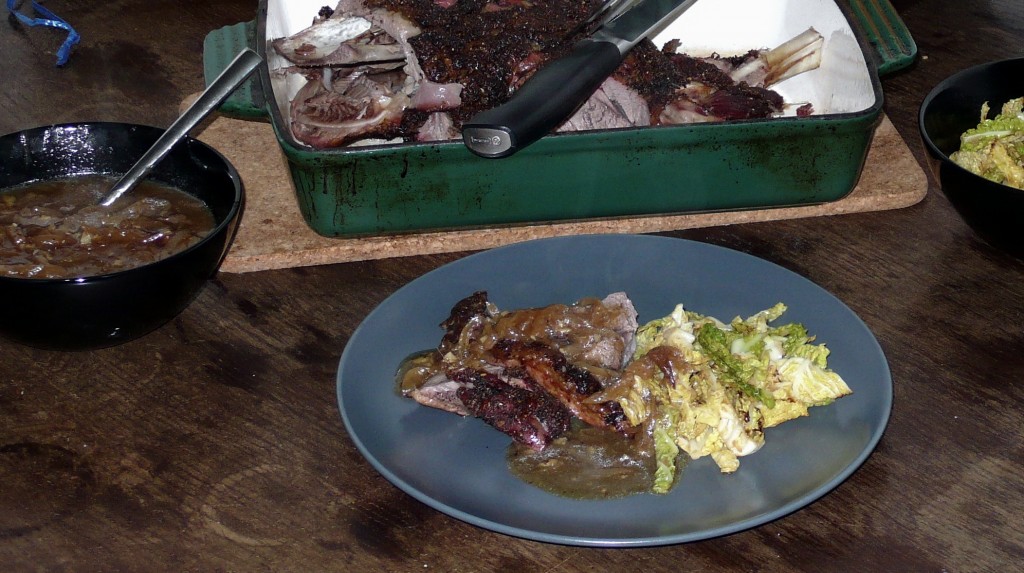 Carve the lamb at the table, sharing out pieces from the various parts of the shoulder. A lamb shoulder cooked like this makes for so many different flavours and textures. There’s the tasty crisp crust, the juicy internal meat, the unctuous fatty edges, the drier but very tasty meat from the leg, and the soft onion-and-beer infused meat from the underside. Serve a selection of these different meat experiences on a plate with a generous helping of onion & ale gravy… and enjoy.
Carve the lamb at the table, sharing out pieces from the various parts of the shoulder. A lamb shoulder cooked like this makes for so many different flavours and textures. There’s the tasty crisp crust, the juicy internal meat, the unctuous fatty edges, the drier but very tasty meat from the leg, and the soft onion-and-beer infused meat from the underside. Serve a selection of these different meat experiences on a plate with a generous helping of onion & ale gravy… and enjoy.
Serve with side dishes of your choice. A bit of steamed cabbage in my case.
3 Good Things: Lamb, Aubergine, Coriander
This recipe has been devised in response to Hugh’s “Three Good Things” challenge. I am, of course, endeavouring to add beer as a sneaky fourth “good thing”. I’m adding it as a subtle addition — much the way the chefs in the TV episodes will gladly include brilliant oils, vinegars, stocks, and herbs without giving them a headline credit.
A slightly exotic twist on a good old roast rack of lamb.
For the second week of Hugh’s “3 good things” challenge I was slightly disappointed, but not surprised, that the challenge meat was not venison. Only because I’d recently butchered an entire fallow deer and currently have a fridge and freezer full of the stuff! Lamb however is a great favourite of mine so I’m not going to knock the excuse to have some for Sunday dinner. I popped out to our local butcher and asked for a rack, but specifically not “French trimmed” — that meat on the back of the bones is the best bit! Quite fatty, and not as tender as the fillet along the bottom, but oh so tasty. I trimmed off just about half an inch at the top to create a bit of “handle” bone (this is finger food!) and BBQed the trimmed strip as a “chef’s perk”. Anyway, this recipe will work just as well with a normally “Frenched” rack.
Rack of lamb is deeply nostalgic for me — growing up it was always a favourite kitchen treat, not to mention a favourite kitchen smell. Sometimes crusted, sometimes plain, often served with some mash. Always eaten with fingers — gnawing all the goodness from those little bones.
Lamb and aubergine are a well loved pairing, think moussaka. In Moroccan recipes coriander often plays a starring role in this combination too. So these are the ingredients I’ve focused on. Aubergine in the form of a rich baba ghanoush, rack of lamb, and a lifting zest of fresh coriander throughout.
Baba Ghanoush (Aubergine Purée)
- Aubergine — I’ve used 3 medium ones
- Garlic clove
- Tahini — to taste
- Light Olive Oil — to taste
- Lemon juice — to taste
- Salt — to taste
- Ground corriander seed — to taste
- Fresh coriander — to taste!
Sorry it’s all “to taste” — use your tastebuds :)
 The most important thing is the char-grilling of your aubergines. Ideally use a charcoal grill. For the baba ghanoush to taste right it really must have that smoky/charred flavour. Unfortunately I only have a gas BBQ handy so I created a little “smoking pack” with some soaked woodchips, coriander seeds, and hops. About a large handful of woodchips will do. I’ve added maybe a tablespoon of coriander seeds, and a few pinches of hops — I have no idea if they contribute notably to the flavour. Grill the aubergines until they’re super-soft inside, a knife should run through them like they’re butter and the knife is red hot.
The most important thing is the char-grilling of your aubergines. Ideally use a charcoal grill. For the baba ghanoush to taste right it really must have that smoky/charred flavour. Unfortunately I only have a gas BBQ handy so I created a little “smoking pack” with some soaked woodchips, coriander seeds, and hops. About a large handful of woodchips will do. I’ve added maybe a tablespoon of coriander seeds, and a few pinches of hops — I have no idea if they contribute notably to the flavour. Grill the aubergines until they’re super-soft inside, a knife should run through them like they’re butter and the knife is red hot.
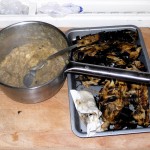 Scoop the flesh out of your aubergines and place into a saucepan and simmer off any excess liquid. You should be able to clear a spot in the bottom of the pan and not have liquid run into it for over a minute. While this is going on I grated in one garlic clove and added lemon juice a little at a time until I was happy with the flavour. Just a little acid, just a little salty. I want the smoky aubergine to shine out here and not be too overwhelmed by the other flavours.
Scoop the flesh out of your aubergines and place into a saucepan and simmer off any excess liquid. You should be able to clear a spot in the bottom of the pan and not have liquid run into it for over a minute. While this is going on I grated in one garlic clove and added lemon juice a little at a time until I was happy with the flavour. Just a little acid, just a little salty. I want the smoky aubergine to shine out here and not be too overwhelmed by the other flavours.
Let the aubergine cool, you can do the next step when you’re ready to serve or it can be done in advance.
The next step is to simply place it in a bowl and energetically whisk in a tablespoon or two of tahini and a gradual drizzle of olive oil until you’re happy with the consistency and flavour.
Finally stir through the ground corriander seed and plenty of roughly chopped fresh coriander leaf – again, to taste. But I like the taste of coriander so I probably put about 4 chopped tablespoons into mine. (Reserve a little coriander for garnishing later.)
Glace de viande avec de la bière? (Reduced stock with stout)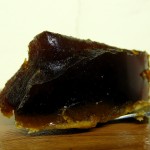
- Rich stock — made with roast lamb bones by preference, beef or game will suffice
- Rich stout — I’ve used Williams Brothers “March of the Penguins”
- Maybe a sprinkle of muscovado sugar
What is the correct term here? In essence we have a strong dark stock that has been reduced until it is thick and gloopy. No thickener used, it isn’t a demi glace.
Reduce your stock down until you have just a few tablespoons with the consistency of runny honey, I started with a stock that isn’t far off this point — it’s solid at 15°C. (Beware if using commercial liquid stock, this will probably end up tasting like a salt-lick — it is worth making your own stock in bulk and keeping it in the freezer in reduced form.) Now add a good rich stout, one that isn’t too bitter, and reduce back to runny-honey. Keep doing this, tasting each stage until you’re happy. I added 130ml of stout to about 100ml of reduced stock. (Ending up with 100ml of reduced stout+stock!) You may add a little sugar if you desire here, just a sprinkle of muscovado at a time until you’re happy.
Carefully keep this warm while you finish off the lamb, you can loosen it with a dash of stout if needed.
- A rack of lamb ;)
- ½ tsp salt
- 1 tsp ground coriander seed
I actually popped my rack of lamb into the BBQ while my aubergine smoke-pack was at its smokiest. Probably only about 15 minutes all up, but this nicely sizzled it a bit too as it gets quite hot under the hood of the BBQ. Alternatively you can pre-sizzle/brown your rack of lamb on a hot charcoal BBQ. Or do the usual trick: brown in a pan on the stove. When sizzled set the lamb aside for little while to cool, you can sizzle it and pop it back in the fridge even if you’re doing your charcoal grilling well in advance.
About half an hour before you’re ready to serve get your oven going nice and hot — about 220°C.
Combine the salt and ground coriander seed and rub thoroughly all over the lamb.
Put the lamb in a roasting tin pop it into the oven.
How do you like your lamb? Rare for me… so I pull it out of the oven after 15 minutes and check the internal temperature with a probe thermometer. It is a bit low… so another 5 minutes in the oven and it’s right. Aiming for mid-40s in degrees Celsius. It will want to rest for 10 minutes now.
Warm plates are essential, or the reduced stock will set solid in an instant!
Drizzle a pattern of the stock & stout reduction on the plates.
Plop a blob of baba ghanoush in the middle.
Carve your rack of lamb into chops and arrange on top.
Drizzle with a little more gravy and sprinkle with some chopped coriander to complete the dish.
Enjoy! With a glass of stout — of course. Use your fingers!

